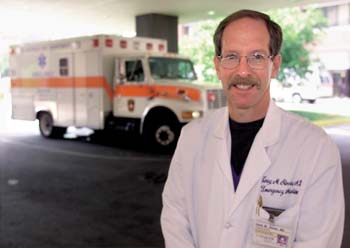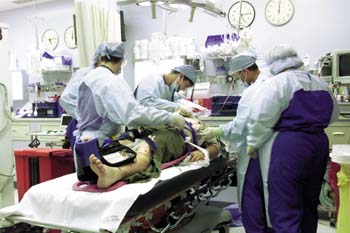
Dr. Corey Slovis, professor and chair of the department of Emergency Medicine. (photo by Dana Johnson)
Space, safety are focus
of Emergency revamp

The planned renovation will alleviate overcrowding in the emergency department. (photo by Anne Rayner)
The adult Emergency Department’s infrastructure will be renovated within the next six to eight months. The Vanderbilt University Board of Trust recently approved a $2.66 million renovation of the main ED to treat the acute setting’s growing pains and bring it up to date. Renovation is slated to begin in July.
“We have a number of problems in the main ER with space and layout that affect how we do our jobs,” said Dr. Corey M. Slovis, professor and chair of the department of Emergency Medicine. “It was designed in the 1970s and built in 1980 and was envisioned to be a clinic and walk-in area for a university hospital, not the home of a regional trauma center.”
The current floor plan was based on an annual patient volume of 20,000. Now, Slovis said, patients and staff are squeezed as the volume in the main ED has almost doubled – total visits to the adult and pediatric EDs exceeds 60,000. The department also treats acute chest pain care and regional toxicology referrals.
“This will be a significant improvement,” Slovis said. “Currently, we’ll have a patient with chest pain next to someone with gunshot wounds to the chest, with only a thin wall between them.”
To better serve trauma and medical emergencies, three new trauma bays will replace the current two. The bays will be twice the size, making them safer and large enough to accommodate six patients in a disaster, Slovis said. They also will be equipped with OR-quality lighting and medical gasses that drop from the ceiling.
The trauma bays will move from their current location along the main corridor to a back wall, where they will be closer to the CT scanner, the elevators to the operating rooms, and the LifeFlight Skyport.
Moving the trauma bays makes room for two additional critical care cardiac rooms. The Fasttrack and occupational medicine areas will also be renovated so staff can see more patients of low acuity quicker, without tying up the main ED, Slovis said.
One of the Fasttrack rooms will be designed especially for sutures and another for otolaryngology, and previous storage space and one small exam room will become two treatment rooms, said John Sparks, architect in the Space and Facilities Planning office.
To accommodate the expansion of the trauma bays, part of the existing admissions office, which shares an interior wall with the ED, will be made smaller and more efficient, Sparks said.
Family and friends accompanying patients will see a new look, too. The waiting area will grow outward, creating new space to almost double the area’s size, and new furniture will be installed.
“It’s not as pretty as it should be,” Slovis said. So, the cramped space will be expanded and modernized with sleek cabinetry and flooring. “It will look newer, bigger, better,” Slovis said.
The work will be done in phases scheduled to work around patient and staff flow, Sparks said. It might take as long as 10 to 12 months to complete the work, he said.













